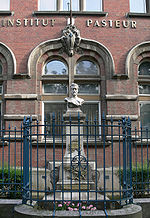
Camille Guérin
Encyclopedia
Jean-Marie Camille Guérin (22 December 1872 – 9 June 1961) was a French veterinarian
, bacteriologist
and immunologist
who, together with Albert Calmette
, developed the Bacillus Calmette-Guérin
(BCG), a vaccine
for immunization
against tuberculosis
.
to a family of modest means. His father died of tuberculosis in 1882 (as well as his wife, in 1918). He studied veterinary medicine at the Ecole Nationale Vétérinaire d'Alfort from 1892 to 1896, working, while a student, as an assistant to pathologist
Edmond Nocard
(1850–1903).
In 1897, he joined the Institut Pasteur de Lille
(Lille
, France
) and started to work with its director, French physician
, bacteriologist and immunologist Albert Calmette
(1863–1933). He started as a technician in charge of preparing Calmette's serum (antivenom against snake
bites) and the vaccine against smallpox
. He improved considerably the production techniques of the later, by using rabbit
s as intermediate hosts, and developed also a method to quantify the remaining virulence of these vaccines.
At Lille, he was promoted to Head of Laboratory in 1900. Thereafter, from 1905 to 1915, and from 1918 to 1928 he devoted himself to the research on a vaccine against tuberculosis, in close association with Calmette, until his death in 1933.
He discovered in 1905 that the bovine tuberculosis bacillum, the Mycobacterium bovis, could immunize the animals without causing the disease. Henceforth, he and Calmette developed ways of attenuate the pathogenic activity of Mycobacterium, using successive transferrals of culture. In 1908, after successfully obtaining an immunologically active preparation that could be use to produced a vaccine, he published with Calmette the results of what was named the BCG.
In 1919 he was promoted again, this time to Head of Services. Finally, in 1921, after 230 passages of the BCG culture, they obtained an effective vaccine that could be used in humans. In 1928 he moved to Paris to became the director of the Tuberculosis Service at the Pasteur Institute.
 In 1939 he became vice-president of the "Comité National de Défense contre la Tuberculose" (National Defense Committee against Tuberculosis). In 1948 Guérin was chairman of the First International Congress on BCG. He was also President of the Veterinary Academy of France (1949), and President of the Academy of Medicine (1951). In 1955, the French Academy of Sciences awarded him the Scientific Grand Prix.
In 1939 he became vice-president of the "Comité National de Défense contre la Tuberculose" (National Defense Committee against Tuberculosis). In 1948 Guérin was chairman of the First International Congress on BCG. He was also President of the Veterinary Academy of France (1949), and President of the Academy of Medicine (1951). In 1955, the French Academy of Sciences awarded him the Scientific Grand Prix.
He died aged 89, in the Hôpital Pasteur in Paris.
Veterinarian
A veterinary physician, colloquially called a vet, shortened from veterinarian or veterinary surgeon , is a professional who treats disease, disorder and injury in animals....
, bacteriologist
Bacteriology
Bacteriology is the study of bacteria. This subdivision of microbiology involves the identification, classification, and characterization of bacterial species...
and immunologist
Immunology
Immunology is a broad branch of biomedical science that covers the study of all aspects of the immune system in all organisms. It deals with the physiological functioning of the immune system in states of both health and diseases; malfunctions of the immune system in immunological disorders ; the...
who, together with Albert Calmette
Albert Calmette
Léon Charles Albert Calmette ForMemRS was a French physician, bacteriologist and immunologist, and an important officer of the Pasteur Institute. He discovered the Bacillus Calmette-Guérin, an attenuated form of Mycobacterium used in the BCG vaccine against tuberculosis...
, developed the Bacillus Calmette-Guérin
Bacillus Calmette-Guérin
Bacillus Calmette-Guérin is a vaccine against tuberculosis that is prepared from a strain of the attenuated live bovine tuberculosis bacillus, Mycobacterium bovis, that has lost its virulence in humans by being specially subcultured in an artificial medium for 13 years, and also prepared from...
(BCG), a vaccine
Vaccine
A vaccine is a biological preparation that improves immunity to a particular disease. A vaccine typically contains an agent that resembles a disease-causing microorganism, and is often made from weakened or killed forms of the microbe or its toxins...
for immunization
Immunization
Immunization, or immunisation, is the process by which an individual's immune system becomes fortified against an agent ....
against tuberculosis
Tuberculosis
Tuberculosis, MTB, or TB is a common, and in many cases lethal, infectious disease caused by various strains of mycobacteria, usually Mycobacterium tuberculosis. Tuberculosis usually attacks the lungs but can also affect other parts of the body...
.
Biography
Camille Guérin was born in PoitiersPoitiers
Poitiers is a city on the Clain river in west central France. It is a commune and the capital of the Vienne department and of the Poitou-Charentes region. The centre is picturesque and its streets are interesting for predominant remains of historical architecture, especially from the Romanesque...
to a family of modest means. His father died of tuberculosis in 1882 (as well as his wife, in 1918). He studied veterinary medicine at the Ecole Nationale Vétérinaire d'Alfort from 1892 to 1896, working, while a student, as an assistant to pathologist
Pathology
Pathology is the precise study and diagnosis of disease. The word pathology is from Ancient Greek , pathos, "feeling, suffering"; and , -logia, "the study of". Pathologization, to pathologize, refers to the process of defining a condition or behavior as pathological, e.g. pathological gambling....
Edmond Nocard
Edmond Nocard
Edmond Isidore Etienne Nocard , was a French veterinarian and microbiologist, born in Provins ....
(1850–1903).
In 1897, he joined the Institut Pasteur de Lille
Institut Pasteur de Lille
The Institut Pasteur de Lille is a research centre, membre of the Pasteur Institute network.It includes 14 research units, 1150 employees including 626 researchers located in Lille . 300 employees located outside the Pasteur site come in addition...
(Lille
Lille
Lille is a city in northern France . It is the principal city of the Lille Métropole, the fourth-largest metropolitan area in the country behind those of Paris, Lyon and Marseille. Lille is situated on the Deûle River, near France's border with Belgium...
, France
France
The French Republic , The French Republic , The French Republic , (commonly known as France , is a unitary semi-presidential republic in Western Europe with several overseas territories and islands located on other continents and in the Indian, Pacific, and Atlantic oceans. Metropolitan France...
) and started to work with its director, French physician
Physician
A physician is a health care provider who practices the profession of medicine, which is concerned with promoting, maintaining or restoring human health through the study, diagnosis, and treatment of disease, injury and other physical and mental impairments...
, bacteriologist and immunologist Albert Calmette
Albert Calmette
Léon Charles Albert Calmette ForMemRS was a French physician, bacteriologist and immunologist, and an important officer of the Pasteur Institute. He discovered the Bacillus Calmette-Guérin, an attenuated form of Mycobacterium used in the BCG vaccine against tuberculosis...
(1863–1933). He started as a technician in charge of preparing Calmette's serum (antivenom against snake
Snake
Snakes are elongate, legless, carnivorous reptiles of the suborder Serpentes that can be distinguished from legless lizards by their lack of eyelids and external ears. Like all squamates, snakes are ectothermic, amniote vertebrates covered in overlapping scales...
bites) and the vaccine against smallpox
Smallpox
Smallpox was an infectious disease unique to humans, caused by either of two virus variants, Variola major and Variola minor. The disease is also known by the Latin names Variola or Variola vera, which is a derivative of the Latin varius, meaning "spotted", or varus, meaning "pimple"...
. He improved considerably the production techniques of the later, by using rabbit
Rabbit
Rabbits are small mammals in the family Leporidae of the order Lagomorpha, found in several parts of the world...
s as intermediate hosts, and developed also a method to quantify the remaining virulence of these vaccines.
At Lille, he was promoted to Head of Laboratory in 1900. Thereafter, from 1905 to 1915, and from 1918 to 1928 he devoted himself to the research on a vaccine against tuberculosis, in close association with Calmette, until his death in 1933.
He discovered in 1905 that the bovine tuberculosis bacillum, the Mycobacterium bovis, could immunize the animals without causing the disease. Henceforth, he and Calmette developed ways of attenuate the pathogenic activity of Mycobacterium, using successive transferrals of culture. In 1908, after successfully obtaining an immunologically active preparation that could be use to produced a vaccine, he published with Calmette the results of what was named the BCG.
In 1919 he was promoted again, this time to Head of Services. Finally, in 1921, after 230 passages of the BCG culture, they obtained an effective vaccine that could be used in humans. In 1928 he moved to Paris to became the director of the Tuberculosis Service at the Pasteur Institute.

He died aged 89, in the Hôpital Pasteur in Paris.
External links
- Jean Marie Camille Guérin. WhoNamedIt site.
- Camille Guérin (1872-1961). Pasteur Institute, Paris (In French).

